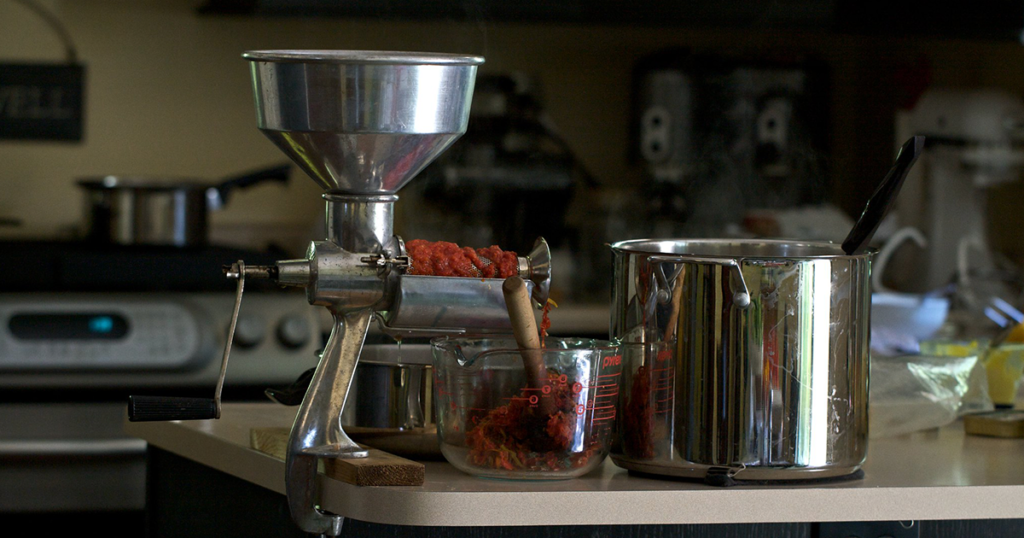
Back before Covid, when running a foot race was a typical weekend activity in Spain for thousands of amateur athletes, and when the dozens of T-shirts that came with the dozens of races piled up unused in closets, people complained. Why another T-shirt? Why not socks, a pair of gloves, or a bottle of wine? And if it’s got to be a T-shirt, why polyester? No using an old polyester T-shirt to clean windows. Oh, for the good old days when you got a cotton T-shirt!
I periodically took my extra race T-shirts to the charity drop for old clothes. Down the hatch went a record of the races I’d run, complete with place and year. It was too much to save and even too much to remember, with almost 300 races under my belt. No need to dwell on past races when another was just ahead.
But I saved the red shirts for canning tomatoes. This August I put up 50 quarts of tomatoes and tomato sauce, compulsively listening day after day to Ian and Silvia sing about the coming winter, untamable rodeo boys, and the cold in Canada. Whenever a sloppy stir of the pot sent a splash of juice onto my T-shirt and I looked down, the Canadian landscape in the song of that moment morphed into a Spanish one, such as the lake and woods and the surrounding stubby, just-harvested chick pea fields near Santa Marina del Rey, a village in dry dusty León. I ran that race four Augusts in a row, taking home a yellow, a green, a white, and a red T-shirt and a garland of garlic.
Or the eight kilometers on the Nalón river path for a race called Ruta de los Museos. It started at the Museum of Mining and Industry in the town of El Entrego and finished at the nearby Pozo Sotón, a mine that closed in 2014 and is now the Mining Experiences and Memory Center. Both museums are in the municipality San Martín del Rey Aurelio, a once-busy coal-mining center in las cuencas, the mining area of deep valleys in the center of Asturias. At the height of the mining boom, 16,000 coal miners worked in 50 mines in las cuencas. After the early ’60s, however, the sector was in trouble, functioning with subsidies, and starting in the ’90s the mines were closed down, a few at a time. Now only one remains, the historic San Nicolás mine, the first Asturian mine to be licensed, in 1876. There, in 1962, the firing of seven miners after they demanded better pay and conditions led to nationwide strikes. Fourteen miners died there in the 1995 mining disaster, one of Asturias’s worst. At the time, 2,000 miners worked in the mine, which back then operated around the clock. About 200 miners work there now. Despite hard-won government concessions after long and violent strikes, no new industry has replaced mining to provide steady, well-paid jobs in the region, and three-quarters of the population decrease in Asturias comes from people leaving the mining valleys to look elsewhere for work. Spain continues to import coal. The Nalón river, once black, is crystal clear.
Just over the border between Asturias and the province of Galicia, I ran the Vía Verde Do Eo race one June and took home a red T-shirt. The race began at the entrance to a tunnel on the vía verde, green track, where the train transporting limonite from the mines at A Pontenova to the sea at Ribadeo once ran, following the Eo river. Now it’s a walking trail. We were running in the opposite direction, along 10 gently rising kilometers beside the river up to A Pontenova, where the five chimneys of the disused limonite blast furnaces were preserved at the edge of the town. A museum displayed artifacts and photos from the illustrious past, when mining had made the area prosperous. It didn’t look prosperous anymore. The mines were shut down in 1964, and the railroad dismantled soon after. Nothing was left of the train but the graded path and a few casetas, the buildings where the coal to power the trains was stored. Of the 34 kilometers to the sea, only 12 have been incorporated in the vía verde, but what I saw of those was beautiful.
What a mixed bag. When exactly were the good old days? Back in the time before you knew what was really worth complaining about. Like the time before Covid-19. The good old days could however be ahead; all it takes is something worse that follows. Even Covid days might become the good old days. Especially if somebody writes a song. Still, I wish I had a new polyester T-shirt to gripe about, just so I could hold my tongue.

